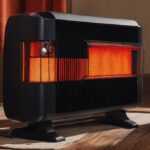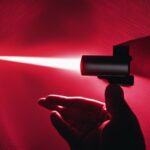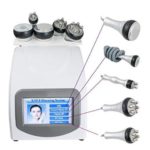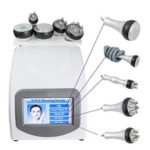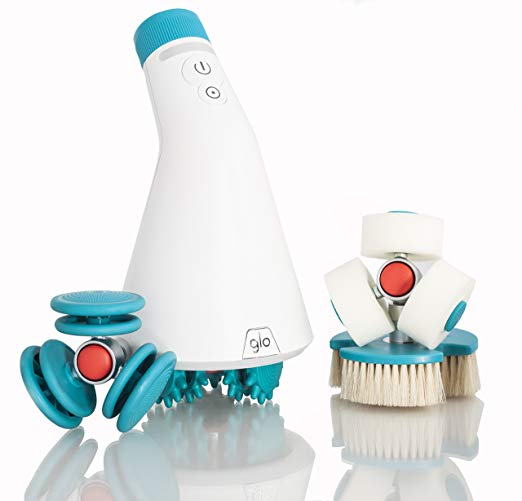Last Updated on 4 months by Francis
When it comes to providing heat for brooders, safety is of utmost importance. Traditional heat lamps have long been associated with fire hazards, posing risks for both property and life. But are there safer alternatives? Infrared heat lamps offer a solution that ensures the warmth needed for brooders without the potential for accidents.
Infrared heat lamps present a safer option compared to their traditional counterparts. These lamps operate on the principle of radiant heat, which does not warm the air but is absorbed by solid objects. This design reduces the risk of overheating and eliminates the fire hazard associated with traditional heat lamps.
- Traditional heat lamps for brooders can pose fire hazards.
- Infrared heat lamps offer a safer alternative for providing heat to brooders.
- Infrared heat lamps operate on the principle of radiant heat.
- These lamps do not warm the air, reducing the risk of overheating.
- Infrared heat lamps eliminate the fire hazard associated with traditional heat lamps.
Contents
The Dangers of Traditional Heat Lamps
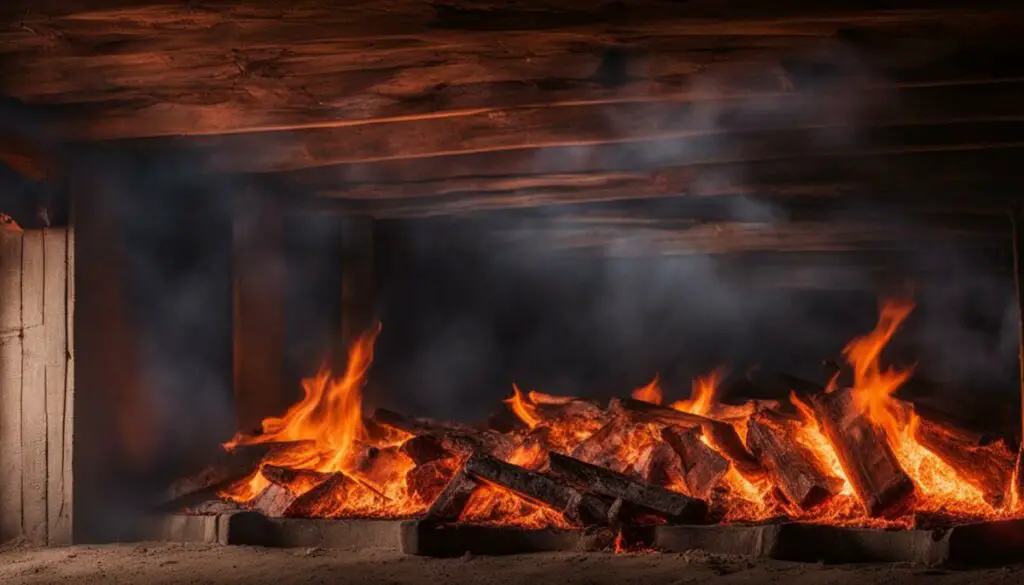
When it comes to providing heat for brooders, traditional heat lamps have long been a popular choice. However, these lamps pose significant risks that cannot be ignored. The use of traditional heat lamps for brooders has been associated with numerous incidents of fires, resulting in damage to property, injuries, and even loss of life.
One of the main dangers of traditional heat lamps is their potential to cause fires. These lamps can easily fall or be knocked over, especially in the active and curious environment of a brooder. Once a heat lamp comes into contact with flammable objects, the risk of ignition becomes high, leading to a fire hazard. This poses a serious threat to both the well-being of the brooder occupants and the surrounding environment.
Moreover, the design of traditional heat lamps includes potential failure points that further contribute to the fire hazard. The clamps used to secure the lamp can be easily dislodged, causing the lamp to fall or tilt at an unsafe angle. Loose wing nuts on the lamp assembly can also compromise the stability of the lamp, increasing the risk of accidents. These design flaws create a situation where even a simple disturbance can result in disastrous consequences.
To illustrate the dangers of traditional heat lamps, consider the following incidents:
“In a recent case, a brooder located in a barn caught fire due to a traditional heat lamp that fell onto a pile of hay. The fire quickly spread, causing extensive damage to the barn and resulting in the loss of several valuable livestock.”
These incidents underscore the importance of reassessing the use of traditional heat lamps for brooders. The risks associated with these lamps are too great to ignore. Fortunately, there are safer alternatives available that eliminate the fire hazard and provide a more secure method of heating brooders.
Safety is paramount
It is essential to prioritize the safety of brooder occupants and the surrounding environment. By understanding the risks associated with traditional heat lamps, brooder owners can make informed decisions to safeguard their flock and property.
| Risks of Traditional Heat Lamps | Safer Alternatives |
|---|---|
| Fire hazard due to falling or contact with flammable objects | Infrared heat lamps |
| Potential failure points in lamp design | Radiant heat sources |
Benefits of Infrared Heat Lamps for Brooders

When it comes to providing heat for brooders, infrared heat lamps offer numerous benefits over traditional heat lamps. Let’s explore the advantages of using infrared heat lamps for brooders and how they compare to their counterparts.
Radiant Heat and Increased Safety
One of the key benefits of infrared heat lamps is their safety. Unlike traditional heat lamps, infrared heat lamps do not pose a fire hazard. This is because they operate on the principle of radiant heat, which is absorbed by solid objects rather than heating the surrounding air. The reduced risk of overheating and fire makes infrared heat lamps a much safer option for brooders.
Energy Efficiency and Cost Savings
In addition to safety, infrared heat lamps are also more energy-efficient compared to traditional heat lamps. By providing radiant heat that directly warms the brooder objects, less electricity is consumed. This not only helps reduce the energy bill but also makes them more environmentally friendly. Over time, the cost savings and energy efficiency of infrared heat lamps can make a noticeable difference.
Comparing Infrared and Traditional Heat Lamps
To better illustrate the advantages of infrared heat lamps, let’s compare them to traditional heat lamps:
| Advantages | Infrared Heat Lamps | Traditional Heat Lamps |
|---|---|---|
| Safety | Fire hazard due to exposed elements | |
| Heat Distribution | Radiant heat targets objects directly | Heats the surrounding air |
| Energy Efficiency | Consumes less electricity | Higher energy consumption |
| Environmental Impact | More eco-friendly | Higher carbon footprint |
As the table shows, infrared heat lamps offer significant advantages in terms of safety, heat distribution, energy efficiency, and environmental impact compared to traditional heat lamps. These benefits make them an ideal choice for brooders.
By opting for infrared heat lamps, brooder owners can provide a safe and efficient heat source for their chicks while enjoying the cost savings and peace of mind that comes with using this technology.
Understanding Brooder Temperature and Heat Requirements

Newly hatched chicks require specific heat conditions in order to thrive. It is crucial to understand the ideal temperature for brooders and the temperature requirements for brooding chicks to ensure their comfort and well-being.
The recommended ideal brooder temperature for the first week of a chick’s life is around 90-95°F. This temperature provides a warm and cozy environment that mimics the warmth provided by a mother hen. As the chicks grow and develop, the brooder temperature should gradually decrease by five degrees each subsequent week.
To regulate brooder temperature effectively, it is important to monitor the temperature of the brooder space using a reliable thermometer. This allows you to adjust the heat source accordingly and ensure that the chicks are neither too hot nor too cold. Maintaining a consistent temperature within the brooder is vital to support the chicks’ growth and overall health.
Remember that chicks are unable to regulate their body temperature like adult birds. They rely on an external heat source to stay warm. Proper heat management is essential to avoid risks such as overheating or chilling, which can have detrimental effects on the chicks’ health.
As chicks grow older and start to develop feathers, they will gradually become more capable of regulating their body temperature. This means that the brooder temperature can be gradually reduced over time, allowing the chicks to acclimate to lower temperatures and prepare for life outside the brooder.
Monitoring and adjusting brooder temperature based on the chicks’ behavior is also important. If the chicks are huddling together and appear cold, it may indicate that the brooder temperature is too low. On the other hand, if the chicks are spread out and panting, it may suggest that the brooder temperature is too high.
By understanding the ideal temperature for brooders and temperature requirements for brooding chicks, you can provide a comfortable and nurturing environment that supports the chicks’ growth and development.
Brooder Temperature Guidelines:
- First week: Maintain brooder temperature at 90-95°F.
- Subsequent weeks: Gradually decrease brooder temperature by five degrees each week.
- Monitor brooder temperature using a reliable thermometer.
- Adjust heat source accordingly to maintain a consistent temperature.
- Observe chick behavior to gauge the appropriateness of the brooder temperature.
| Brooder Age | Ideal Temperature (Fahrenheit) |
|---|---|
| First week | 90-95°F |
| Second week | 85-90°F |
| Third week | 80-85°F |
| Fourth week | 75-80°F |
| Fifth week | 70-75°F |
Choosing the Right Heat Source for Brooders
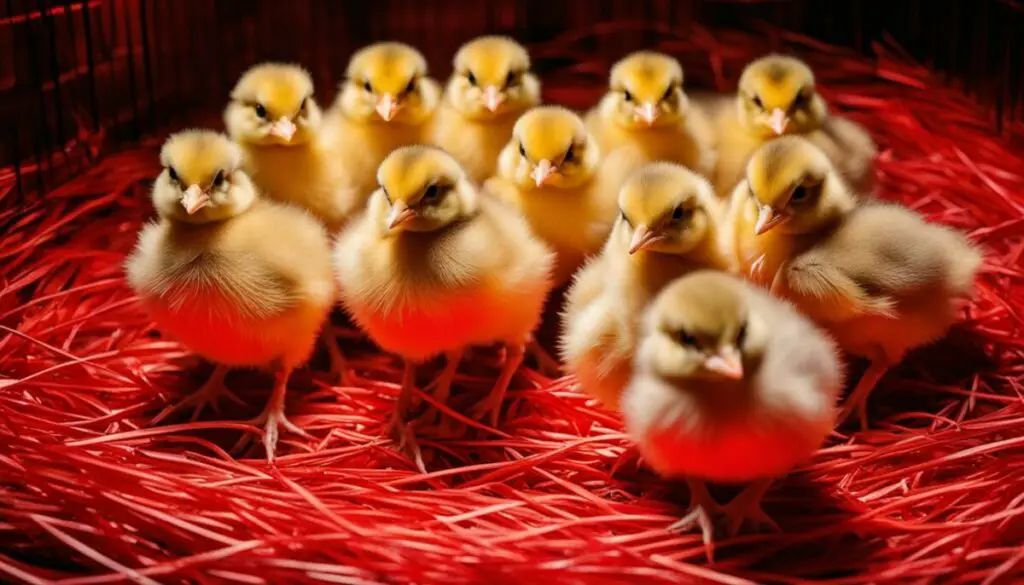
When it comes to selecting a heat source for brooders, safety and effectiveness should be your top priorities. Traditional incandescent and infrared bulbs are commonly used, but they have their drawbacks. Fire hazards and the potential to disrupt the chicks’ sleep patterns are significant concerns. It’s important to explore alternative heat sources that offer a safer and more efficient solution for brooders.
Comparing Heat Sources
Let’s take a closer look at some of the best heat sources for brooders:
| Heat Source | Advantages |
|---|---|
| Infrared Heat Lamps |
|
| Radiant Heat Plates |
|
| Heating Pads |
|
Each heat source has unique advantages, and the best choice depends on your specific needs and preferences. However, considering the safety and well-being of the chicks, radiant heat sources such as heat plates and heating pads offer a safer alternative to traditional incandescent and infrared bulbs.
Radiant heat sources emit heat from a solid surface, ensuring a stable and controlled temperature without the risk of fire. They provide a more natural environment for the chicks, mimicking the warmth of a mother hen. Additionally, these heat sources are energy-efficient and reduce the chances of sleep disruption, allowing the chicks to rest and grow undisturbed.
Using a safe and efficient heat source for your brooders is crucial to create a comfortable and secure environment for your chicks. Consider the advantages of radiant heat sources like heat plates and heating pads to provide a safer alternative and ensure the best possible conditions for your brooder.
Tips for Using Heat Lamps in Brooders Safely

When it comes to keeping your brooders warm and cozy, heat lamps are commonly used. However, ensuring the safe use of heat lamps is crucial to prevent accidents and create a secure environment for your chicks. Follow these brooder lamp safety tips and heat lamp safety precautions to ensure the well-being of your brooders:
- Securely hang the lamp: Use a heatproof chain to hang the heat lamp in the brooder. This will prevent it from falling or being knocked over, reducing the risk of fires.
- Avoid using cheap or low-quality heat lamps: Invest in high-quality heat lamps that are specifically designed for brooders. Cheap or low-quality lamps may have design flaws and increase the risk of accidents.
- Monitor the brooder temperature: Regularly check the temperature inside the brooder using a reliable thermometer. Maintain the ideal brooder temperature to prevent overheating or chilling of the chicks.
- Observe the chicks’ behavior: Pay attention to how the chicks behave inside the brooder. If they are huddling together excessively or staying away from the heat lamp, it may indicate that the temperature needs adjustment.
By following these heat lamp safety tips and brooder lamp safety precautions, you can create a safe and comfortable environment for your chicks to grow and thrive.
“Invest in high-quality heat lamps that are specifically designed for brooders.”
Remember, the safety of your brooders depends on the precautions you take. Prioritize the well-being of your chicks by implementing these safety measures and ensuring brooder safety with heat lamps.
<!–
| Tips for Using Heat Lamps Safely |
|---|
| Securely hang the lamp using a heatproof chain |
| Avoid using cheap or low-quality heat lamps |
| Monitor the brooder temperature and adjust accordingly |
| Observe the chicks’ behavior to prevent overheating or chilling |
–>
Benefits of Radiant Heat Sources for Brooders
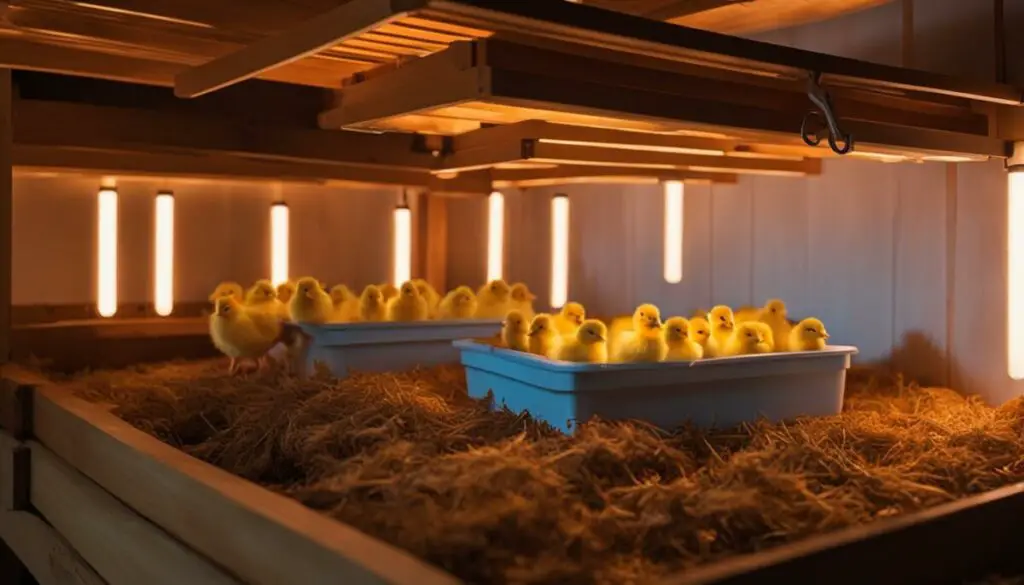
Radiant heat sources, such as the Brinsea EcoGlow Brooder, offer several advantages for brooders. These heat sources provide the chicks with a warm and comfortable environment, mimicking the natural warmth provided by a mother hen. This allows the chicks to regulate their own comfort levels and promotes healthy development.
One of the key benefits of radiant heat sources is their improved safety compared to traditional heat lamps. Unlike heat lamps, radiant heat sources do not pose a fire hazard. This eliminates the risk of accidental fires and provides peace of mind for brooder owners.
Another advantage of radiant heat sources is their energy efficiency. The Brinsea EcoGlow Brooder, for example, consumes less electricity compared to traditional heat lamps. This can result in cost savings over time, making radiant heat sources a more economical option for brooders.
The use of radiant heat sources also creates a more natural sleeping environment for the chicks. Unlike traditional heat lamps that emit light, radiant heat sources provide warmth without disruptive lighting. This allows the chicks to maintain their natural sleep patterns, promoting healthy rest and growth.
Overall, the Brinsea EcoGlow Brooder and other radiant heat sources offer significant benefits for brooders. They provide a safe and comfortable heating option, consume less electricity, and promote natural sleep patterns for the chicks. These advantages make radiant heat sources an excellent choice for brooder owners looking to create a nurturing environment for their chicks.
Monitoring and Adjusting Brooder Temperature
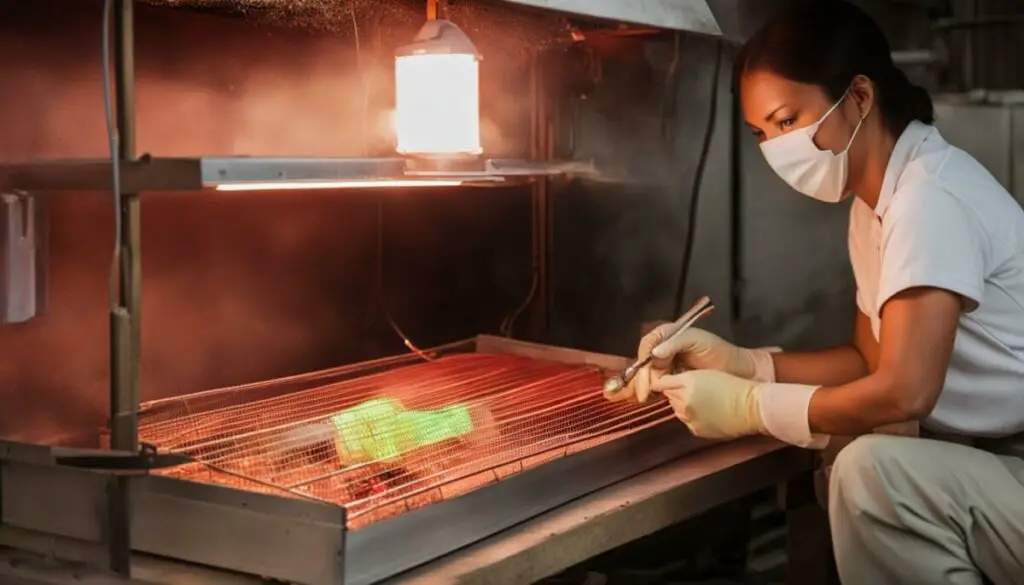
Ensuring the optimal temperature in the brooder is crucial for the comfort and well-being of the chicks. To maintain a suitable environment, it is essential to regularly monitor and adjust the brooder temperature. Here are some key strategies to consider:
1. Multiple Thermometers for Even Heat Distribution
Placing multiple thermometers at different spots within the brooder can help monitor the temperature more accurately and ensure even heat distribution. This way, you can identify any hot or cold spots and make necessary adjustments to provide a consistent temperature throughout the brooder.
2. Observing Chick Behavior as Indicators
Chick behavior can provide valuable insights into the brooder temperature. Pay attention to how the chicks are behaving. If they are huddled together, it may indicate that the temperature is too low, and the chicks are trying to stay warm. On the other hand, if they are spreading out and panting, it might suggest that the temperature is too high, and the chicks are trying to cool down.
Tip: By carefully observing the chicks’ behavior, you can make timely adjustments to the brooder temperature, ensuring their comfort and promoting healthy growth.
3. Gradual Temperature Adjustments
When making temperature adjustments, it’s essential to do so gradually. Sudden changes in temperature can stress the chicks and negatively impact their development. Gradually increase or decrease the brooder temperature by a few degrees at a time, allowing the chicks to adjust gradually as well.
4. Regularly Monitor, Record, and Maintain
To ensure consistent and correct brooder temperature, it is necessary to regularly monitor the temperature, record the data, and maintain proper settings. This helps identify any fluctuations or inconsistencies and enables you to take immediate action to rectify any issues.
5. Seek Expert Advice if Needed
If you’re unsure about how to best monitor and adjust the brooder temperature for your chicks, don’t hesitate to consult with experts or experienced poultry breeders. They can provide valuable guidance and insights based on their expertise and practical experience.
By employing these strategies and closely monitoring the brooder temperature, you can create a comfortable and safe environment for the chicks to thrive and develop.
| Monitoring and Adjusting Brooder Temperature | Method |
|---|---|
| Placing multiple thermometers at different spots within the brooder |
|
| Observing chick behavior as indicators |
|
| Gradual temperature adjustments | Allows chicks to adjust gradually without stress |
| Regular monitoring, recording, and maintenance | Identifies fluctuations and inconsistencies |
| Seeking expert advice if needed | Consulting with experienced poultry breeders |
Brooder Heat Source Considerations
When it comes to choosing the best heat source for brooders, there are several factors to consider. The well-being and safety of the chicks should be the top priority. Taking into account the number of chicks, ambient temperature, and potential fire hazards is essential to make an informed decision.
Infrared bulbs are a popular choice among brooder owners due to their ability to provide warmth without disturbing the chicks’ sleep. However, it is crucial to exercise caution and take necessary precautions to prevent fire risks. The use of proper fixtures, ensuring the stability of the bulb, and keeping combustible materials away from the heat source are important safety measures.
Alternatively, radiant heat sources, such as heating plates, offer a safer alternative for brooders. These heat sources provide uniform and gentle warmth, mimicking the natural heat provided by a mother hen. Heating plates eliminate the risk of fire hazards associated with heat lamps and allow chicks to regulate their own comfort levels.
Factors to Consider When Selecting a Heat Source for Brooders:
- The number of chicks: Consider the size of the brooder and the number of chicks it can comfortably accommodate. A heat source that evenly distributes heat throughout the brooder is essential to ensure all chicks receive sufficient warmth.
- Ambient temperature: The prevailing temperature in the environment should be taken into account when selecting a heat source. Some heat sources may be more suitable for colder climates, while others may work better in warmer conditions.
- Potential fire hazards: Assess the potential risks associated with the heat source. Traditional heat lamps have a higher risk of causing fires compared to radiant heat sources. Ensure proper installation and follow safety guidelines to minimize fire hazards.
By considering these factors, brooder owners can make an informed decision when selecting a heat source. Prioritizing the safety and comfort of the chicks will result in a healthier and happier brooder environment.
Conclusion
In conclusion, infrared heat lamps provide a safer and more efficient option for brooders compared to traditional heat lamps. By eliminating the fire hazard associated with heat lamps, these infrared lamps ensure the well-being and safety of both the chicks and the brooder environment. Additionally, infrared heat lamps allow the chicks to regulate their own comfort levels, mimicking the warmth provided by a mother hen.
Understanding the brooder temperature requirements and selecting the right heat source are crucial steps in creating a safe and nurturing environment for the chicks. Infrared heat lamps not only meet the temperature needs of the chicks but also consume less electricity, making them a cost-effective choice in the long run.
Overall, when it comes to brooder heat sources, infrared heat lamps offer significant safety benefits and allow for optimal growth and development of the chicks. By utilizing infrared heat lamps and following the necessary temperature monitoring and adjustment practices, brooders can provide a secure and comfortable space for chicks to thrive and flourish.
FAQ
Are infrared heat lamps safer for brooders?
Yes, infrared heat lamps offer a safer alternative to traditional heat lamps for brooders. They do not pose a fire hazard and provide heat through radiant heat, reducing the risk of overheating.
What are the advantages of using infrared heat lamps for brooders?
Infrared heat lamps consume less electricity, mimic the warmth provided by a mother hen, and create a more natural sleeping environment for chicks without disruptive light.
How do infrared heat lamps compare to traditional heat lamps for brooders?
Infrared heat lamps are safer and more cost-effective than traditional heat lamps. They eliminate fire hazards and provide a more comfortable and efficient heat source for brooders.
What is the ideal temperature for brooders?
The ideal brooder temperature for the first week of a chick’s life is around 90-95°F, gradually decreasing by five degrees each subsequent week.
How do I choose the right heat source for brooders?
When choosing a heat source for brooders, consider factors such as the number of chicks, ambient temperature, and fire hazards. Options include infrared bulbs and radiant heat sources like heating plates.
What are some tips for using heat lamps in brooders safely?
To use heat lamps safely in brooders, securely hang the lamp with a heatproof chain, avoid using cheap or low-quality lamps, and monitor the brooder temperature to prevent overheating or chilling.
What are the benefits of radiant heat sources for brooders?
Radiant heat sources, such as the Brinsea EcoGlow Brooder, provide a safer alternative to heat lamps. They mimic the warmth provided by a mother hen, consume less electricity, and do not pose a fire hazard.
How do I monitor and adjust the brooder temperature?
Place multiple thermometers in different spots within the brooder to ensure even heat distribution. Observe chick behavior, such as spreading out or huddling together, to determine if the temperature needs adjustment.
What factors should I consider when selecting a heat source for brooders?
Consider the number of chicks, ambient temperature, and the potential for fire hazards when choosing a heat source for brooders. Infrared bulbs and radiant heat sources, such as heating plates, are popular options.
What are the safety benefits of using infrared heat lamps for brooders?
Using infrared heat lamps for brooders eliminates fire hazards and provides a safe and warm environment for chicks to thrive. These lamps do not pose the same risks as traditional heat lamps.

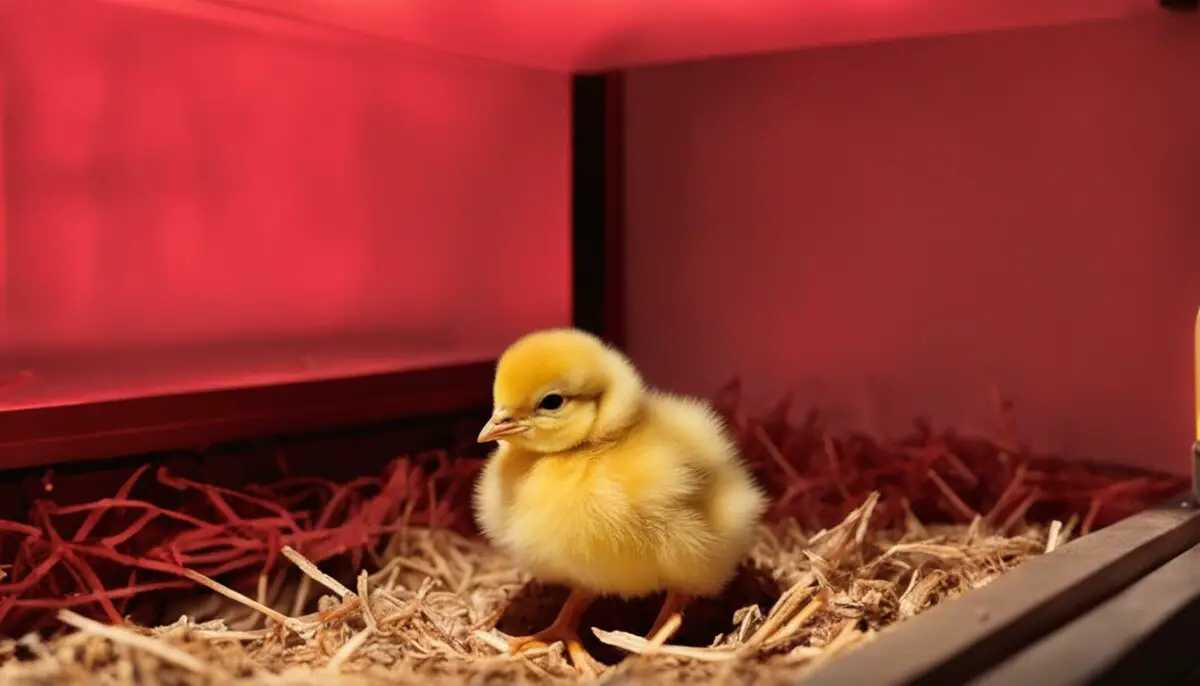

.jpg)
